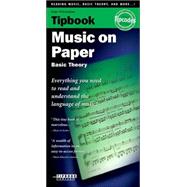
| Hear What You Read with Tipcode www.tipbook.com: With the Tipcodes in this book you can actually hear most of the musical examples. Here's how it works | p. VIII |
| Music on Paper: A basic guideline for this book, so you know where every item of interest can be found | p. 1 |
| High and Low: The basics about high and low notes, staffs, and clefs | p. 5 |
| Long and Short: Each note's appearance tells you how long it should sound. Short notes, long notes, rests, bars, and meters | p. 15 |
| Sharps and Flats: A sharp (#) raises a note by a half tone; a flat ([flat]) lowers it | p. 27 |
| Loud and Soft: The dynamic markings: from fortisissimo (very, very loud) to pianissimo (really, really soft) | p. 36 |
| Fast and Slow: The tempo of a piece is indicated by the number of beats per minute, or by Italian words | p. 39 |
| Articulation: The symbols and words that tell you exactly how a note should be played | p. 43 |
| Ornaments: In music, ornaments are decorative notes that embellish the main notes | p. 47 |
| Section Markings and Repeat Signs: The signposts in a written piece of music | p. 51 |
| Major and Minor: A chapter on major and minor keys, and the scales they're based on | p. 57 |
| The Circle of Fifths: Explains how all the different keys are related | p. 69 |
| Intervals: Everything you need to know about intervals--the musical distances between two notes | p. 73 |
| More About Major and Minor: Variations on the minor scale, the circle of fifths, relative minor and major keys, and how to figure out which key a piece is in | p. 80 |
| Other Scales: More scales, from the traditional modes to the blues | p. 87 |
| Transposition: Why a C can sound at a different pitch on some instruments, and how to change the key of a piece of music | p. 92 |
| Time, Meter, and Rhythm: The downbeat, triple meter, swing, and more | p. 96 |
| Do, Re, Mi--I, II, III: Notes can also be indicated by syllables and Roman numerals | p. 100 |
| Chords, Tab, and Drum Music: An introduction to chord symbols, chord diagrams, tablature, and music for drummers | p. 102 |
| Putting Notes to Paper: Tips on scoring--the actual writing of notes | p. 107 |
| Back in Time: A quick look at the history of music notation | p. 110 |
| Signs and Markings: The signs and markings covered in this book | p. 112 |
| Glossary and Index: What is a coda, a fermata, or a ghost note? All is explained in this glossary, which doubles as an index | p. 113 |
| Essential Reference: For quick reference: the major and minor scales, a do-it-yourself scale wheel, and memory aids | p. 126 |
| Table of Contents provided by Rittenhouse. All Rights Reserved. |
The New copy of this book will include any supplemental materials advertised. Please check the title of the book to determine if it should include any access cards, study guides, lab manuals, CDs, etc.
The Used, Rental and eBook copies of this book are not guaranteed to include any supplemental materials. Typically, only the book itself is included. This is true even if the title states it includes any access cards, study guides, lab manuals, CDs, etc.